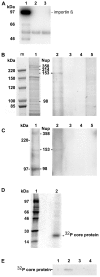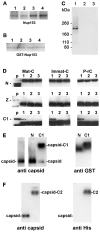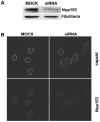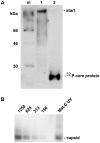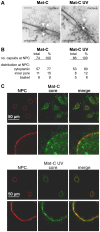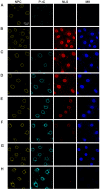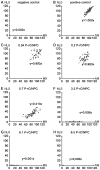Nucleoporin 153 arrests the nuclear import of hepatitis B virus capsids in the nuclear basket - PubMed (original) (raw)
Nucleoporin 153 arrests the nuclear import of hepatitis B virus capsids in the nuclear basket
André Schmitz et al. PLoS Pathog. 2010.
Abstract
Virtually all DNA viruses including hepatitis B viruses (HBV) replicate their genome inside the nucleus. In non-dividing cells, the genome has to pass through the nuclear pore complexes (NPCs) by the aid of nuclear transport receptors as e.g. importin beta (karyopherin). Most viruses release their genome in the cytoplasm or at the cytosolic face of the NPC, as the diameter of their capsids exceeds the size of the NPC. The DNA genome of HBV is derived from reverse transcription of an RNA pregenome. Genome maturation occurs in cytosolic capsids and progeny capsids can deliver the genome into the nucleus causing nuclear genome amplification. The karyophilic capsids are small enough to pass the NPC, but nuclear entry of capsids with an immature genome is halted in the nuclear basket on the nuclear side of the NPC, and the genome remains encapsidated. In contrast, capsids with a mature genome enter the basket and consequently liberate the genome. Investigating the difference between immature and mature capsids, we found that mature capsids had to disintegrate in order to leave the nuclear basket. The arrest of a karyophilic cargo at the nuclear pore is a rare phenomenon, which has been described for only very few cellular proteins participating in nuclear entry. We analyzed the interactions causing HBV capsid retention. By pull-down assays and partial siRNA depletion, we showed that HBV capsids directly interact with nucleoporin 153 (Nup153), an essential protein of the nuclear basket which participates in nuclear transport via importin beta. The binding sites of importin beta and capsids were shown to overlap but capsid binding was 150-fold stronger. In cellulo experiments using digitonin-permeabilized cells confirmed the interference between capsid binding and nuclear import by importin beta. Collectively, our findings describe a unique nuclear import strategy not only for viruses but for all karyophilic cargos.
Conflict of interest statement
The authors have declared that no competing interests exist.
Figures
Figure 1. Co-immune precipitation of Nup153 from rat nuclear extracts with Immat-C.
A. Importin β binding of Nups after renaturation. Nuclear extract was incubated with importin β and FXFG repeat-containing Nups were precipitated using mAb414-coated biomagnetic beads. Panel A depicts an immune blot using an anti-importin β antibody showing that importin β was co-precipitated by the nucleoporins. 1: mAB414-coated beads + nuclear extract+importin β. 2: mAB414-coated beads without nuclear extract + importin β. 3: Uncoated beads+nuclear extract + importin β. The 54 kDa band present in all lanes represents the heavy chain of the antibodies. The bands at 66 and 47 kDa in lane 1 are most likely degradation products of Imp β. B. Protein co-precipitation by capsids from nuclear extract. Sypro Red stain after SDS PAGE. m: marker. The MW is listed on the left. 1: nuclear extract without precipitation. The migration of different nucleoporins is indicated on the right. 2: Co-immune precipitation of nuclear extract with Immat-C bound to anti capsid antibody-coated biomagnetic beads. 3: Negative control without nuclear extract. 4: Beads only. 5: Co-immune precipitation of nuclear extract without Immat-C by anti capsid antibody-coated biomagnetic beads. The stain shows a precipitation of a protein with an apparent MW of ∼180 kDa. C. Immune blot of the nuclear protein(s), which were co-precipitated by Immat-C. Immune detection was performed using mAb414. 1–5 as in Figure 1B. The blot shows that the co-precipitated protein is mAb414-reactive. D. Phosphoimager scan of 32P-labeled Immat-C (lane 2) and marker (lane 1) showing that a single protein was labeled. E. Phosphoimager scan of precipitations in which 32P-labelled Immat-C was incubated with nuclear extracts followed by precipitation of nucleoporins, which were bound to mAb414-coated biomagnetic beads. Capsid-co-precipitation is indicated by the radioactive core proteins on an SDS PAGE. 1: mAb414-coated beads without nuclear extract + capsids 2: Anti capsid coated beads + nuclear extract + capsids, 3: Anti capsid coated beads + nuclear extract without capsids, 4: Uncoated beads + nuclear extract + capsids. The figure shows that Immat-C precipitates Nup153 from the nuclear extract of rat liver.
Figure 2. Co-immune precipitations of human Nup153 and Nup153 fragments with different capsids.
A–D. Capsids were incubated with nuclear extract, GST-Nup153 or Nup153 fragments and precipitated with anti-capsid antibody-coated biomagnetic beads. The panels show immune blots after SDS PAGE. A–C: Detection by mAb414. A. 1 Immat-C, 2 Mat-C, 3 P-rC, 4 ΔC-rC. Co-precipitations of Nup153 from nuclear extracts showed that capsids precipitate Nup153 irrespective to the nucleic acid inside the capsid or the presence of the C terminus of the core protein. B. Co-precipitations of bacterially expressed GST-Nup153 showed that all capsid species directly interact with Nup153. 1 Immat-C, 2 Mat-C, 3 P-rC, 4 ΔC-rC. C. Specificity controls of GST-Nup153 co-precipitation exemplified by P-rC. 1. Positive control. P-rC + GST-Nup153 + anti capsid antibody-coated beads. 2. Without capsids + GST-Nup153 + anti capsid antibody-coated beads. 3. P-rC + without GST-Nup153 + anti capsid antibody-coated beads. D. Co-precipitation of GST-Nup153 fragments by P-rC. Immune detection of the Nup153 fragments by anti-GST antibodies bound to anti mouse coated biomagnetic beads. The GST-Nup153 fragment is given on the left of the panels, the capsid type at the top. p: GST-Nup153 fragment without precipitation (positive control). 1: P-rC + Nup153 fragment + anti capsid antibody-coated beads. 2: No capsids + Nup153 fragment + anti capsid antibody-coated beads. 3. P-rC + Nup153 fragment + uncoated beads. The figure shows that only the C1 fragment, which comprises aa 618–999 of Nup153, is precipitated by the capsids. E. Gel retardation of P-rC by GST-Nup153 N and C1 fragment on native agarose gels. The migration of GST-Nup153 N and C1 fragments without capsids is shown by anti-GST antibodies (right panel). The migration of the capsid without GST-Nup fragments is shown on the left panel using anti-capsid antibodies. The middle panel shows the capsid migration in the presence of GST-Nup153 N (left lane) and C1 (right lane). F. Gel retardation of P-rC by GST-Nup153 C2 fragment. Left: anti-capsid blot, right: anti-His blot. Left lanes: P-rC without Nup153 fragment, right lanes: P-rC with Nup153 fragment.
Figure 3. Competition of P-rC, Imp β and Nup153 interactions.
A. Nup153 was preincubated with importin β and P-rC. The complex was precipitated by anti capsid antibody-coated beads and Nup153 was detected by Immune blot using mAb414. − negative control without P-rC, +: positive control in the absence of Imp β. 1–5. Different ratios of capsid-importin β. 1: 1∶33, 2: 1∶50, 3: 1∶100, 4: 1∶150, 5: 1∶300. B. Anti capsid antibody-coated beads were preloaded with P-rC. P-rC was then saturated with Nup153 followed by addition of different excesses of Imp β.−: and +: as in A. Molar ratio capsid-Imp β 1: 1∶2600, 2: 1∶4000, 3: 1∶5400, 4: 1∶6700. The figure shows that even an excess of Imp β cannot displace Nup153-bound capsids. After Nup153 attachment to the capsid even excessive amounts of Imp β cannot replace Nup153.
Figure 4. Nuclear import of P-rC in nuclei of partially Nup153-silenced cells.
A. Immune blot of Nup153 in Nup153-silenced cells. Upper panel Nup153, lower panel: the house keeping gene Fibrillarin. The blot shows a significantly reduced Nup153 expression B. Nuclear import in digitonin-permeabilized cells. Left: control mock-transfected cells. Right: Nup153-silenced cells. Capsids and Nup153 are visualized by indirect immune fluorescence (see as well video in Supporting information). Consistent with the incomplete Nup153 knock down some P-rC entered the nucleus exclusively in Nup153 siRNA-treated cells.
Figure 5. Analysis of cross-linked core particles.
A. Lane 1: 32P-labelled Mat-C-UV and (lane 2) 32P-labelled Mat-C were separated on a 4–12% SDS-PAGE. Phosphoimaging showed that the core proteins of Mat-C-UV did not enter the separating gel indicating successful cross-linking. In contrast the core proteins of Mat-C migrated as a 21.5 kDa band. m: 14C-labelled molecular weight marker. B. Immune blot of Mat-C-UV and non cross-linked P-rC after native agarose gel electrophoresis. Mat-C-UV migrated as the P-rC standard indicating that the core proteins were linked within the individual capsids and that the capsids were not linked to each other. The identical migration indicates that UV irradiation has not changed the surface charge. The numbers on top of the standard dilution series give the amount of the P-rC in pg.
Figure 6. Nuclear transport of Mat-C and Mat-C-UV.
A. Electron microscopy of the capsids at the NPCs after microinjection into the cytoplasm of Xenopus laevis oocytes. The white arrows indicate capsids. Black scale bar: 100 nm. B. Frequency of NPC-attached capsids and the capsid distribution at the NPCs. Both capsid species showed a similar frequency at the NPCs and similar importation into the nuclear basket. C. In vitro transport assays of the capsids in digitonin-permeabilized HuH-7 cells. NPCs (red) and capsids (green) are visualized by indirect immune stain. The merges are depicted on the right panels. The panels show overviews and strongly magnified images. While Mat-C (upper two panels) caused intranuclear fluorescence cross-linked capsids (lower two panels) failed to enter the karyoplasm.
Figure 7. In vitro transport assays of NLS- and M9-linked fluorescent BSA conjugates after preload of the NPCs by P-rC.
NPCs (yellow) were visualized by indirect immune fluorescence using mAb414. P-rC (cyan): Indirect capsid immune fluorescence using anti capsid antibodies. The panel show increasing signal strength related to the amounts of capsids subjected to the cells. NLS (red): fluorescence of Alexa594 NLS-BSA. M9 (blue): Fluorescence of Alexa647 M9-BSA. While the NLS-import rapidly decreased with increasing preload of the NPCs with P-rC, the M9-import was less affected. A. Negative control at 4°C without capsid preload. B. Positive control at 37°C without capsid preload. C. Preload of the nuclei with 25 ng P-rC, D. 100 ng P-rC, E. 400 ng P-rC, F. 1600 ng P-rC, G. 6400 ng P-rC, H. 12800 ng P-rC. All pictures were taken at the same magnification. Space bar: 20 µm.
Figure 8. Scatter plots of the relative intranuclear concentrations of M9- and NLS-BSA in individual cells preloaded with P-rC.
Each point represents one cell. X-axis: Intranuclear concentration of the M9-BSA. Y-axis: Intranuclear concentration of NLS-BSA. Both axes give the relative intranuclear cargo concentration in %. The dotted lines show the regression lines. The corresponding slope is given in each panel. The average number of capsids per NPC is given on top of each panel. A. Negative control at 4°C. B. Positive control without capsid preload. C.–H. Increasing amounts of P-rC as in Figure 8. 100%: mean value of the positive import reaction. Only those cells were analyzed in which the section was within the equatorial region (570 cells total).
Figure 9. Schematic model of intranuclear basket events leading to genome release from the hepatitis B virus capsid.
A. Capsids in complex with the nuclear transport receptors Import α and β attach to the nuclear pore. B. The complex passes the nuclear pore and becomes arrested by interaction between importin β and Nup153. C. RanGTP dissociates the nuclear transport receptors from the capsid and recycles them into the cytoplasm. D. After removal of the nuclear transport receptors Nup153 interact directly with the capsid. Immature Capsids remain in the arrested statebut eventually undergo further maturation. E. Mature capsids disintegrate. F. Capsid subunits, which are supernumerous to the Nup153 copies, diffuse into the nucleus. The polymerase-viral DNA complex leaves the basket. The central framework of the NPC is shown as black spheres, Nup153 as red boxes, Import α and β complex as green ellipse. The capsids are depicted as hexagons, containing the rcDNA genome (black circles) and the polymerase (grey sphere).
Similar articles
- Nuclear import of hepatitis B virus capsids and release of the viral genome.
Rabe B, Vlachou A, Panté N, Helenius A, Kann M. Rabe B, et al. Proc Natl Acad Sci U S A. 2003 Aug 19;100(17):9849-54. doi: 10.1073/pnas.1730940100. Epub 2003 Aug 8. Proc Natl Acad Sci U S A. 2003. PMID: 12909718 Free PMC article. - Cytoplasmic Parvovirus Capsids Recruit Importin Beta for Nuclear Delivery.
Mäntylä E, Aho V, Kann M, Vihinen-Ranta M. Mäntylä E, et al. J Virol. 2020 Jan 31;94(4):e01532-19. doi: 10.1128/JVI.01532-19. Print 2020 Jan 31. J Virol. 2020. PMID: 31748386 Free PMC article. - Nuclear entry of hepatitis B virus capsids involves disintegration to protein dimers followed by nuclear reassociation to capsids.
Rabe B, Delaleau M, Bischof A, Foss M, Sominskaya I, Pumpens P, Cazenave C, Castroviejo M, Kann M. Rabe B, et al. PLoS Pathog. 2009 Aug;5(8):e1000563. doi: 10.1371/journal.ppat.1000563. Epub 2009 Aug 28. PLoS Pathog. 2009. PMID: 19714236 Free PMC article. - Nuclear entry and egress of parvoviruses.
Mattola S, Aho V, Bustamante-Jaramillo LF, Pizzioli E, Kann M, Vihinen-Ranta M. Mattola S, et al. Mol Microbiol. 2022 Oct;118(4):295-308. doi: 10.1111/mmi.14974. Epub 2022 Aug 24. Mol Microbiol. 2022. PMID: 35974704 Free PMC article. Review. - Intracellular transport and egress of hepatitis B virus.
Blondot ML, Bruss V, Kann M. Blondot ML, et al. J Hepatol. 2016 Apr;64(1 Suppl):S49-S59. doi: 10.1016/j.jhep.2016.02.008. J Hepatol. 2016. PMID: 27084037 Review.
Cited by
- Identification and characterization of a novel bipartite nuclear localization signal in the hepatitis B virus polymerase.
Lupberger J, Schaedler S, Peiran A, Hildt E. Lupberger J, et al. World J Gastroenterol. 2013 Nov 28;19(44):8000-10. doi: 10.3748/wjg.v19.i44.8000. World J Gastroenterol. 2013. PMID: 24307793 Free PMC article. - A theoretical study of SRPK interaction with the flexible domains of hepatitis B capsids.
Kim J, Wu J. Kim J, et al. Biophys J. 2014 Sep 16;107(6):1453-61. doi: 10.1016/j.bpj.2014.07.032. Biophys J. 2014. PMID: 25229152 Free PMC article. - Hepatitis B Virus Capsid: The Core in Productive Entry and Covalently Closed Circular DNA Formation.
Mendenhall MA, Hong X, Hu J. Mendenhall MA, et al. Viruses. 2023 Feb 28;15(3):642. doi: 10.3390/v15030642. Viruses. 2023. PMID: 36992351 Free PMC article. Review. - Hepatitis B virus: virology, molecular biology, life cycle and intrahepatic spread.
Karayiannis P. Karayiannis P. Hepatol Int. 2017 Nov;11(6):500-508. doi: 10.1007/s12072-017-9829-7. Epub 2017 Nov 2. Hepatol Int. 2017. PMID: 29098564 Review. - Structural organization of pregenomic RNA and the carboxy-terminal domain of the capsid protein of hepatitis B virus.
Wang JC, Dhason MS, Zlotnick A. Wang JC, et al. PLoS Pathog. 2012 Sep;8(9):e1002919. doi: 10.1371/journal.ppat.1002919. Epub 2012 Sep 20. PLoS Pathog. 2012. PMID: 23028319 Free PMC article.
References
- Lim RY, Aebi U, Stoffler D. From the trap to the basket: getting to the bottom of the nuclear pore complex. Chromosoma. 2006;115:15–26. - PubMed
- Terry LJ, Shows EB, Wente SR. Crossing the nuclear envelope: hierarchical regulation of nucleocytoplasmic transport. Science. 2007;318:1412–1416. - PubMed
- Tran EJ, Wente SR. Dynamic nuclear pore complexes: life on the edge. Cell. 2006;125:1041–1053. - PubMed
Publication types
MeSH terms
Substances
LinkOut - more resources
Full Text Sources
Molecular Biology Databases
